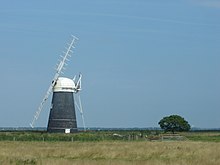Halvergate Marshes
| Site of Special Scientific Interest | |

Muttons Mill, partially restored and located on the Halvergate Marshes
|
|
| Area of Search | Norfolk |
|---|---|
| Grid reference | TG450050 |
| Coordinates | 52°35′17″N 1°36′54″E / 52.588°N 1.615°ECoordinates: 52°35′17″N 1°36′54″E / 52.588°N 1.615°E |
| Interest | Biological |
| Area | 1,430.13 hectares (14.30 km2; 5.52 sq mi) |
| Notification | 1981 |
| Natural England website | |
The Halvergate Marshes are an area of grazing marsh in the east of the English county of Norfolk. They form part of the area of The Broads and lie between the River Bure and the River Yare, bordering Breydon Water on the east. The marshes cover an area of around 2,642 hectares (26.42 km2; 10.20 sq mi) Over half of the area is designated as a Site of Special Scientific Interest as well as a Ramsar Site and forms part of the Broadland Special Protection Area.
Halvergate Marshes were an estuary in Roman times and remained a tidal creek into the Medieval period. By the time of Domesday Book the land was already being used for grazing sheep, with Halvergate being recorded as having 960 sheep at the time, a larger amount than any other part of the marshes. Some evidence of possible salt workings also remains. Around 400 years ago the land was drained and converted to grazing marsh using a series of windpumps or windmills and drainage ditches. It was used mainly to graze sheep and cattle, although was occasionally farmed as arable land until coastal flooding in the 1780s.
Arable ploughing in the 1960s and 70s damaged the ditch landscape and ecology and in the 1980s further draining was undertaken. This led to the loss of wildlife habitat and in 1981 an area 1,430 hectares (3,500 acres) in size was designated as a Site of Special Scientific Interest. In 1985 the Broads Authority, Ministry of Agriculture, Fisheries and Food and Countryside Commission developed the Broads Grazing Marsh Conservation Scheme, a series of financial incentives to persuade farmers to adopt more environmentally friendly methods on Halvergate Marshes. This led to the creation of the UK's first Environmentally Sensitive Area on Halvergate Marshes in 1987 and was the prototype for ESAs nationally.
...
Wikipedia

